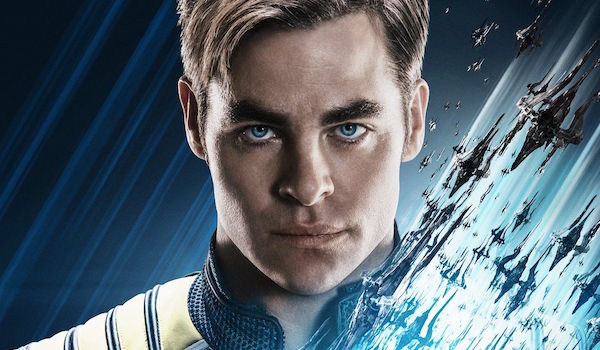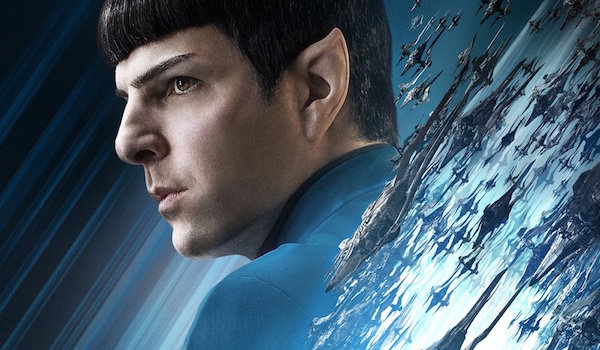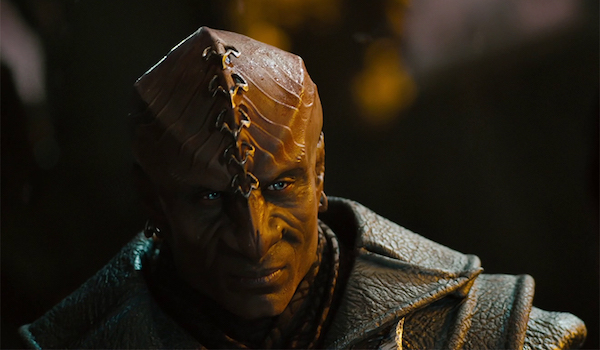Star Trek 101: Everything You Need To Know Before Star Trek Beyond

This year marks Star Trek's 50th anniversary. What started as a science fiction primetime program following space exploration a couple years before we'd landed on the Moon, became a pop culture phenomenon spawning other TV shows, movies, books, comics, games and plenty more. There have been some bumps over the years, but the franchise remains a way to not only show off cool action and unique aliens, but also explore interesting social issues and ideas. However, something so large may intimidate newcomers from wanting to partake in the fun. Don't worry, we've got you covered.
This Friday will finally see the release of Star Trek Beyond, the third movie in the reboot series and the 13th movie overall. To celebrate its release and the franchise's huge milestone, we've put together this guide, to go over all the important elements surrounding the franchise, with most of the focus resting on the "Original" characters, both from the '60s and the new versions that are currently on the big screen. Here are all the Star Trek basics you need to know before seeing Star Trek Beyond.

Star Trek: The Original Series
After creator Gene Roddenberry made two pilots in 1964 and 1965, respectively ("The Cage" and "Where No Man Has Gone Before," both of which eventually aired/made available to the public), Star Trek finally premiered on NBC September 8, 1966. The series followed the Enterprise crew as they went on their five-year mission to explore strange new worlds, to seek out new life and new civilizations, and to boldly go where no man/no one has gone before. While the sets, effects and even some episodes may not have always been top-notch, the series made its mark by exploring themes and ideas that few TV shows at the time were willing to touch upon.
Star Trek: The Original Series ended in 1969, but it continued to impact viewers in reruns, and that, along with a short-lived animated series, led to the Enterprise crew reuniting in 1978's Star Trek: The Motion Picture. Five more movies followed, concluding with 1991's Star Trek VI: The Undiscovered Country. That was the last time the original Enterprise crew were together, though all of the main characters, with the exception of Uhura, guest starred on one of the later TV shows and/or briefly appeared in the 1994 movie Star Trek: Generations.

James Kirk
William Shatner will always be best remembered for playing James T. Kirk for nearly three full decades, but for the reboot movies, Chris Pine has taken over as the captain of the Enterprise. His childhood may have been different thanks to the events of the 2009 movie (we'll get to that later), but at his core, the alternate timeline's Kirk is still the same as he was in the Prime Universe. He's cocky (becoming Starfleet's youngest captain no doubt boosted this), he's headstrong and he frequently thinks outside the box when solving problems. He's also notorious for breaking regulations, and if it were any other officer, they would have been sacked long ago. Fortunately, Kirk gets results, and while he has faced consequences for his actions on some occasions, the status quo usually reverts to normal.

Spock
In contrast with James Kirk, Spock, the Enterprise's First Officer, is driven by logic and following the rules. That's not surpassing since he's half Vulcan, a race that pushes down their emotions in favor of experiencing life more practically... most of the time. Leonard Nimoy played Spock in the series (he was the only character from "The Cage" pilot to remain a series regular), and later, six movies and two Star Trek: The Next Generation episodes, while Zachary Quinto is now officially the new Spock. Nimoy also reprised his version of Spock in Star Trek and Star Trek Into Darkness. One difference between the original and new version of Spock is that the new movies have arguably placed more emphasis on his human side. He's in a relationship with fellow crew member Nyota Uhura, and during moments of great loss or pain, he's succumbed to anger and sadness.

Leonard McCoy
The third leading man in the Star Trek cast (at least by Original Series standards) is Dr. Leonard McCoy, the Enterprise's Chief Medical Officer who was first portrayed by DeForrest Kelley, but is now brought to life by Karl Urban. He's also known as "Bones," a nickname which was originally shortened from "sawbones," an archaic term for surgeons, but in the new movies was attributed to his ex-wife leaving him "nothing but his bones" in the divorce. Kirk and McCoy have been close friends for years, to the point that they're basically brothers. However, while he and Spock are also friends, McCoy is frequently frustrated by the Vulcan's detached nature, which wildly contrasts with his own passionate personality. Regardless, McCoy has demonstrated many times that he has an excellent understanding on anatomy, both human and many alien races. Just don't forget that he's a doctor, not a fill in the blank.
Your Daily Blend of Entertainment News

The Other Main Crew Members
The Enterprise is full of hundreds of crew members, but for viewers, there are four other characters who round out Star Trek's main cast. First, there's Chief Engineer Montgomery Scott, a.k.a. Scotty, originally played by James Doohan and now played by Simon Pegg. You can always count on Scotty to be jovial (and in Pegg's version's case, more comical) and to give the Enterprise gives everything she's got when flying.
Second, there's helmsman Hikaru Sulu, originally played by George Takei and now played by John Cho. In addition to his position on the bridge, Sulu is also quite athletic and a talented swordsman. Third, there's Communications Officer Nyota Uhura, originally played by Nichelle Nichols and now played by Zoe Saldana. Her main duties are manning the comm and translating alien languages, and in the new movies, she has also been romantically involved with Spock. Finally, we have Pavel Chekov, who, in the Original Series, wasn't introduced until Season 2. Walter Koenig originally occupied the role, and he was played in the reboot movies by the late Anton Yelchin. Aside from being the navigator, Chekov is best remembered for his distinctive Russian accent.

Starfleet
In the Star Trek universe, humanity achieved warp flight technology in the mid-21st century, thus kicking off a new era for Earth. By the 22nd century, Starfleet had been established, though the first iteration was only connected to Earth, while the later, more notable one is an arm of the United Federation of Planets. The scientific organization's goals are benevolent: exploring the galaxy, studying other kinds of life and culture, going on diplomatic missions, etc. Although Starfleet's personnel are peacekeepers and don't want to do harm (with some exceptions), their ships are armed with weapons in case they need to defend themselves, allies or innocents being targeted. Of course, not every being looks at Starfleet as a force for good. There are some who would love nothing more than for it to be eliminated. The latest individual to try to accomplish that is Star Trek Beyond's antagonist Krall.

The Prime Directive
As mentioned in the previous section, Starfleet sends its ships out to explore the galaxy. Often times they'll run into other advanced alien races, but sometimes, they'll discover a world still stuck in a primitive state. When that happens, the crew of that ship must follow the Prime Directive, i.e. they are not allowed to interfere with the natural development of a civilization. The idea is that rather than Starfleet impose their own values by providing advanced technology, these races need to develop on their own. Of course, as longtime Star Trek fans know, the Prime Directive has been frequently broken, whether accidentally or on purpose. The most recent example of the latter was when Kirk and the Enterprise prevented a volcano from destroying all life on a primitive planet in Star Trek Into Darkness. Consequently, the Enterprise was seen by the natives (seen above), and the ship was looked at by them as a god.
The Prime Directive also applies to advanced worlds, like not getting involved in internal political matters or staying away if the leaders of a society doesn't want Starfleet around.There is also a Temporal Prime Directive established centuries in the future from the main Star Trek eras, which explicitly commands time travelers from changing events in the past.

The Enterprise
You can't think of Star Trek without thinking its most famous ship, the USS Enterprise, a.k.a. NCC-1701. Within the universe's chronology, The Original Series' Enterprise was the first to bear that name, but for TV viewers, it will always be the starship that kicked off the whole shebang. As with other ships in Starfleet, the Enterprise travels across the galaxy with its warp drive, and is armed just enough to make it a formidable threat in anyone picks a fight with the crew. The Original Series Enterprise was destroyed in Star Trek III: The Search for Spock, and by Star Trek IV: The Voyage Home, it was succeeded by the Enterprise-A. Four more Enterprise ships would be created over the next century, with the latter two being manned by the Next Generation characters.

Vulcans
Humanity has made many alliances with alien races in the Star Trek universe, and chief among them are the Vulcans. They were nearby when Zefram Cochrane made the first warp flight, and seeing that humanity was ready to get involved with the rest of the galaxy, they publicly presented themselves to us, i.e. made first contact. The primary Vulcan physical feature are their pointed ears, though if they bleed, you'll notice blood is green. Vulcans are also capable of contact telepathy, like "mind melding" with someone else or passing their "katra" to someone else to essentially cheat death. They are also excellent fighters whenever non-violence isn't an option, with the "Vulcan neck pinch" being their trademark move to incapacitate someone.
As mentioned earlier when discussing Spock, the Vulcans prefer to have logic dictate their actions rather than emotions, as the latter nearly drove their ancestors insane. Most Vulcans are able to suppress their emotions on their own, but the best students also complete the Kolinahr ritual, which would completely purge all emotion. Every seven years, a Vulcan must also submit to pon farr, where a hormone imbalance forces them to mate with someone in order to properly deal with the effects, though other methods have also been used to treat it.

Classic Star Trek Villains
We could spend hours discussing the greatest Star Trek villains over the TV shows and movies, so for this feature, we're providing a brief rundown of the best adversaries the original Star Trek characters have face over the years. Chief among them are the Klingons, a warrior race who love battle, but also cherish honor. They are primarily recognizable by their brown skin, sharp teeth and, for many of their population, forehead ridges (seen above). There are also the Romulans, who look almost identical to the Vulcans. The Romulans descended from Vulcan ancestors who refused to suppress their emotions. So while the Vulcans are primarily nonviolent and use logic to dictate their actions, the Romulans are emotional and love nothing more than conquest and exerting their power.
Other villains who the Original Series characters faced include Khan Noonien Singh, Gary Mitchell, the Tholians, the Mirror Universe counterparts, etc. The list of Star Trek enemies gets even bigger when you account for the folks introduced in the Next Generation era, like the Borg, Cardassians and Q. So if you're eager to join Starfleet and travel the galaxy, just know there quite a few individuals, groups and races who will want to hurt you badly.

The Other TV Shows
Star Trek: The Original Series may have begun this entire craze, but the franchise wouldn't have stayed alive for as long as it has without the other TV shows. Following the first four theatrical movies, Star Trek: The Next Generation began airing in 1987. The series followed Captain Jean-Luc Picard and the crew of the Enterprise-D (seen above) on the same mission of exploration nearly 100 years after the events of the Original Series. After that series concluded in 1994, those characters' story continued in four movies, the last being 2002's Star Trek: Nemesis.
In 1993, Star Trek: Deep Space Nine was added to the slate. Unlike the other shows, this took place on a space station, and was notable for being darker and having more of an ongoing storyline. Star Trek: Voyager hit the airwaves in 1995, and it literally distanced itself from the other shows by stranding the crew of the eponymous ship in the Delta Quadrant. Finally, Star Trek: Enterprise aired from 2001-2005, and follow the first starship Enterprise (dubbed NX-01) as they explored the galaxy 100 years before The Original Series.
Next year, CBS will air a new Star Trek TV series exclusively on their All Access streaming service, though the pilot will be shown on the actual channel. Few details have been released about the new show, but it will reportedly take place between the Original Series and Next Generation eras, and will also feel more like an anthology series.

The Events Of The Previous Reboot Movies
The Star Trek franchise has frequently explored other timelines, but it was the 2009 Star Trek movie that gave fans their most important alternate reality yet. In the Prime Universe (a.k.a. the original continuity), Leonard Nimoy's Spock attempted to destroy a supernova that was nearing the planet Romulus by creating a black hole using red matter. His attempt failed, and he was sucked through the black hole and was transported back in time to when the main Star Trek characters were active. Unfortunately, a Romulan named Nero and his followers were also sucked in by the black hole. They arrived about 20 years earlier than Spock, and they were pissed that their loved ones were dead.
These events kicked off the changes in this new timeline, namely with Kirk's dad dying on the Kelvin (the Starfleet ship that discovered Nero coming through the temporal portal) and Vulcan (the planet) being destroyed by Nero as revenge for losing Romulus. Still, the original crew managed to meet each other and defeat Nero together, and by the end of the movie, they were off on their way to explore the galaxy together.
2013's Star Trek Into Darkness picked up a few years later when a new villain appeared seemingly out of nowhere to destroy Starfleet. This man was originally called John Harrison, but it was revealed halfway through the movie (even though some fans had already guessed correctly) that he was really Khan Noonien Singh, who the "Prime" Enterprise crew had fought in the Original Series episode "Space Seed" and the movie Star Trek II: Wrath of Khan. Just Ricardo Montalbán's version, Benedict Cumberbatch's Khan was a superhuman, both physically and mentally. His actions even led to Kirk temporarily dying, though the captain was later revived. Spock was eventually able to incapacitate Khan and put him back in stasis, and one year after the movie's events, the Enterprise crew began their infamous five year mission. Star Trek Beyond will reunite with the crew approximately halfway through this endeavor.

Connoisseur of Marvel, DC, Star Wars, John Wick, MonsterVerse and Doctor Who lore, Adam is a Senior Content Producer at CinemaBlend. He started working for the site back in late 2014 writing exclusively comic book movie and TV-related articles, and along with branching out into other genres, he also made the jump to editing. Along with his writing and editing duties, as well as interviewing creative talent from time to time, he also oversees the assignment of movie-related features. He graduated from the University of Oregon with a degree in Journalism, and he’s been sourced numerous times on Wikipedia. He's aware he looks like Harry Potter and Clark Kent.
